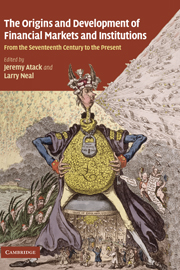 The Origins and Development of Financial Markets and Institutions
The Origins and Development of Financial Markets and Institutions Published online by Cambridge University Press: 04 August 2010
On September 17, 2007, the UK experienced its first bank run in over 140 years. Early that morning, nervous depositors all over the UK began queuing outside their local branches of Northern Rock bank to redeem their deposits (often their life savings) while the bank still had the cash to meet their demands. They had heard the reassuring words over the preceding weekend from Bank of England Governor Mervyn King, including the announcement that the Bank had extended a $4.4 billion line of credit, and they were worried. British deposit insurance rules limited full coverage to just the first £2,000 of a deposit and only 90 percent of the balance up to the insurance cap of £35,000. As a result, many depositors had substantial sums at risk. The run ended only when the Chancellor of the Exchequer, Alistair Darling, overruled the British regulator of banks, the Financial Services Authority, by suspending deposit insurance rules and promising unlimited 100 percent coverage to all existing depositors in the bank as of midnight, Wednesday, September 19, 2007 for the duration of the crisis. Nevertheless, as 2008 began, the crisis was still on-going with no end in sight. As of mid-December 2007, the Bank of England and the British taxpayers had extended at least £25 billion in credit to the bank (about $50 billion) but Northern Rock depositors have continued to withdraw their funds. There were even ministerial discussions about whether or not to nationalize the bank to protect the taxpayers' investment.
To save this book to your Kindle, first ensure [email protected] is added to your Approved Personal Document E-mail List under your Personal Document Settings on the Manage Your Content and Devices page of your Amazon account. Then enter the ‘name’ part of your Kindle email address below. Find out more about saving to your Kindle.
Note you can select to save to either the @free.kindle.com or @kindle.com variations. ‘@free.kindle.com’ emails are free but can only be saved to your device when it is connected to wi-fi. ‘@kindle.com’ emails can be delivered even when you are not connected to wi-fi, but note that service fees apply.
Find out more about the Kindle Personal Document Service.
To save content items to your account, please confirm that you agree to abide by our usage policies. If this is the first time you use this feature, you will be asked to authorise Cambridge Core to connect with your account. Find out more about saving content to Dropbox.
To save content items to your account, please confirm that you agree to abide by our usage policies. If this is the first time you use this feature, you will be asked to authorise Cambridge Core to connect with your account. Find out more about saving content to Google Drive.